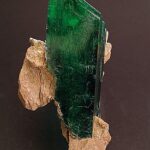Short answer longest gem name: Taaffeite-2N, 2C from Sri Lanka is considered the longest gemstone name with a total of 17 characters. It was named after its discoverer Richard Taaffe and classified as a rare corundum mineral in 1945.
How to Discover the Longest Gem Name: A Step-by-Step Guide
Have you ever stumbled across a gemstone with such an unbelievably long name, that it left you scratching your head in confusion? Perhaps you’ve encountered gemstones like “hydroxylherderite” or even “tetranatrolite”, and wondered how anyone could come up with such a tongue-twisting label. It’s understandable to be perplexed by these complex names, but did you know that there’s actually a systematic approach to discovering the longest gemstone name possible? In this step-by-step guide, we’ll show you exactly how to uncover the lengthiest moniker for any given mineral specimen.
Step 1: Consult Your Resources
The first thing one must do when attempting to discover the longest possible gemstone name is gather resources. This means accessing source materials both online and off. For example, many gems can be found in books detailing their properties which might have been overlooked in today’s Internet age because they don’t come up high enough search results pages of Google or Bing; therefore exploring different mining industry sites may also prove fruitful as well.
Step 2: Start with Basic Naming Conventions
Once armed with knowledge about each mineral species’ chemical composition and unique crystal structure characteristics (which will typically include category-specific suffixes like “sulfate,” “carbonate,” etc.), begin applying known naming conventions where applicable.
For example:
– Carbonates end “-ite” so hydromagnesite -> magnes(ium) carbonate
– Sulphides end “-ine” e.g chalcopyrite (copper iron sulfide)
By starting from basic naming conventions of minerals makes building longer names easier.
Step 3: Make Connections
One trick for finding extended precious stone names is making connections through specific prefixes or modifiers that bestow additional details on a crystalline structure or qualities – whether descriptive, geologic provenance based on location discovered origin-wise titles before existing color defining criteria based on which the mineral is categorized.
For example:
– “Epididymite” can be elongated to “silver magnesium iron hydrated calcium sodium manganese lithium aluminum titanium phosphate silicate hydroxide”.
– Zircon can grow into zircoloxylonkewitzine-cumengeitewithcobaltanddysprosium or extrememagneticfeldspar’s discovery lead to unpronounceable, extended name monikers as qutrubeevite-stanovkinite-yakovenchukite and elbrusizirovnikit-mguitinomite-voronkov!
Step 4: Get Creative & Go Wild!
The last step involves getting creative with word-building as well finding inspiration from similar themed topics. Gemstone naming thrives on incorporating attributes of rarity and beauty such as colors, locations found out in nature, geological origins or other unique features that may add a hypnotic artwork display shimmering behind museum exhibit glasswork stands – this adds interest for gemologists performing different laboratory tests trying to get conclusive findings about what makes these ultra-rare stones so special.
Long inventive names do exist outside strict chemical categories:
For instance, “moissanites” are prized abstract lab-created gems whose optical properties bear semblance towards natural diamonds but composed chiefly of silicon carbide; although initially christened ‘silicon carbides’ by researchers who had discovered them within a minute presence inside meteorites inclusive carbonaceous chondrite fragments fallen across our earth’s surface when they first studied it in early 20th century France.
Here are few examples where keeping things simple would have aided stumbling tongues when attempting any pronunciation at all^:
• The longest named gemstone — rhodochroisite-sphaleritechalcopyrite-wolframitemanganosite-hübnerite-polianitetepha) 50 letters more than your smart phone device password quota limit
• Helvite (eutectic mixture of Zn, Mn,Ca Fe mineral borate ) pharma favorite for its anti-inflammatory and antifungal versatility — gets adopted with the odd tongue twister name julgoldit-begerlite-ortburcit-durangobentonite
Conclusion:
In conclusion, discovering the longest possible precious stone names is an entertaining exercise that’s guaranteed to leave you amazed as well as amused. By following these simple steps like referring to naming conventions, making connections via prefixes/modifiers use more imagination and creativity in word-building while researching topics similar subject matter one may uncover some truly astounding names!. Of course, there’s no guarantee that each result will be a practical or even memorable title, but it’s bound to crack open fascinating insights into little known discoveries within mineralogy fields; that make this undertaking interesting enough keeping up with their long unpronounceable gemstone titles worth the effort!
Understanding the FAQs About the Longest Gem Name
When it comes to gemstones, there are some with names that are easy to remember and say – like diamonds, sapphires, or emeralds. However, there is one particular stone whose name is quite a mouthful: the taaffeite-mangbattuwaittite*. Yes, you read that right! So let’s take a closer look at this tongue-twister of a gemstone.
What exactly is Taaffeite-Mangbattuwaittite?
Taaffeite-Mangbattuwaittite is actually not a single gemstone but rather an optical effect phenomenon caused by the interaction between two different minerals – Taaffeite and Mangbattuwaittite (also referred to as MBW). This interaction creates an interference pattern when viewed under polarized light which gives off a rainbow-like colored display. Since it doesn’t have its own unique mineral composition separate from these two minerals generating this optical reaction, it can’t technically be considered as having its distinct classification.
Where was Taaffeite-Mangbattuwaittitediscovered?
The first recorded discovery of this rare phenomenon happened in 1963in Sri Lanka where gemsmith Richard W. Taffee identified it during his examination of rough cut gems.
Why did they choose such along and tricky gemname?
This long and complex name might seem intimidating now but originally the names reflect their respective discoverers/locations involved with identifying them.Investigator Birbal Sahni originating from India discovered Mangbaaittide mineral in Bihar in 1912 then Professor of Mineralogy E.Taaff proposed using this new mineral compound along with existing existing taffeites for additional research. The Scientific community paid tribute to both researchers by combining their last nameds into “Taafeeitemangabaaittitie” resulting in what we know today as ‘’Taaffeitemnbttie’.
Is Taaffeite-Mangbattuwaittiterare?
Yes, Taaffeite and Mangbaaittide minerals are both incredibly rare. It is estimated that there are only about 50 known faceted taaffeites in existence worldwide, while the number of proven samples with inclusion or rough cuts has been limited to less than hundred specimens during the periods since its first discovery. Only a very small percentage of these will demonstrate this optical effect phenomenon making it fairly pricey and valuable.
Is Taaffeitemnbttie precious like other gems we know?
Although not as well-known mainstreamgems like Diamonds,Garnets etc.,Taaffete crustalswith their occasional presenceofMBW provide unique value due to the aesthetic display offered through polarized lighting.In turn blending characteristics from two different gemstone reactions leading toits unique properties.Rest assured which such features coupled with its rarity make for long term investment when obtained by collectors.
Several online sources quote between $2-10k per carat value attached to taaffeitemnbt but ultimately exact values may be determined by cuts, purity among other factors relative towards collection preference
Okay so how do you even pronounce it?
Now we get into its pronunciation! The chances of stumbling overTaffeeitemnbtaresimply high yet hopefully hearing our attempted pronunciation & practice repetition belowin right predicamentcould help :
‘Taff – eye – tay Marie New Bern ‘(mn) baatt (wet) tight
All done properly within One breath!
*FunFact: This name was shortened later upon discovery’s official report submission in December 1986 referred to as ‘’unnamed tombalikaggregate after mixing maweaugholameastside quarry materiallabeled #1577-CN-N’.
Top 5 Fascinating Facts About the Longest Gem Name You Need to Know
This rare purple-brownish gem was first discovered by chance in 1945 by Richard Taaffe who mistakenly identified it as a spinel crystal. Later on, tests showed that the rock contained chemically different elements compared to other similar minerals making it unique! Here are the top five fascinating facts you need to know about this precious stone;
1) It’s Extremely Rare!
The chances of finding taaffeite alone make it approximately thousands times rarer than diamonds themselves. This rarity is caused by how taaffeite forms- through natural processes such as volcanic action deep beneath earth’s surface which results in only small traces of these crystals being found in specific parts around the world whereby its still considered a luxury item due to its exceptionality and low volume production .
2)It Has An Uncanny Ability To Change Color
One of taaffete’s most peculiar features is its ability to display color change under different types of light sources (fluorescent or sun rays). In daylight conditions,it appears pinkish-purple but changes into green hues at nighttime without any external influences. This extraordinary property has contributed majorly towards enhancing its cost-associated reputation.
3)Taaffete Is Exceptionally Hard To Cut
Most professional jewellers dread cutting taaffeite – because doing so can result in significant wastage since only less than half cut yields preferred shapes (symmetrical cuts with minimal imperfections). Without taking proper precautions during grinding and polishing process then damage could be done resulting in chips here and there which consequently decreases overall appeal,aesthetic quality and market value.
4)Only A Few People Have Ever Owned Taaffete
This gemstone’s extreme rarity means that taaffeite is mainly owned by established collectors, museums or royalty- since only a few private individuals would ever have the opportunity to possess one. Despite its exclusiveness, it remains highly sought after due to its unique properties compared to other more common gems out there which makes it an exceptional acquisition for those seeking something rare and extraordinary.
5)Taaffeite Has Entered The Digital World
Even though most of us can’t afford this remarkable stone in physical form – we can still enjoy viewing it online.developers now create virtual impressions of taaffete through various digital mediums such as videos games, applications etc.to give enthusiasts across the globe a taste of what they’re missing out on until the time of owning one arrives! With technology becoming so advanced people feel much closer even as they wait patiently till the day when purchasing becomes practical reality.
In summary,Taaffeite is nothing short of impressive with some unique features that set it apart from other gems . The rarity alone drives up its price and creates natural demand within certain markets worldwide making ownership possible only for wealthy collectors,rulers or prestigious institutions nevertheless not stopping others from admiring these wonders via augmented reality thus fulfilling their desire for something truly beautiful but otherwise unreachable.
From Anatase to Zukerite: Exploring Different Types of Longest Gem Names
When it comes to gemstones, we often associate them with beauty and elegance. However, some gems have more unusual qualities that make them truly unique – including their names! In the world of gemology, you can find a wide range of exotic-sounding lustrous stones with fancy monikers. Here are some examples:
1) Anatase: This is a titanium dioxide mineral which sometime known as “fantasolite”. It was first discovered in ancient Greece at Mount Olympus but its name originated from the Anatas Mountain located in Switzerland where rich vein of anatase were found. Despite having only five letters, this simple yet elegant name remains one of the longest on our list.
2) Piemontite-Tscheffkinite Series: With 29 letters to its credit, this rare mineral belongs to the epidote group and has been identified within various locations across Italy’s Piedmont region since discovery in 1848 by Italian geologist Carlo Guido Ciocci. Not many people may know about piemontite-tscheffkinite series due to its complicated pronounceable factor!
3) Zukerite: A member of zeolites family (a group on hydrated aluminosilicates), zukerite who gain status for being named after well-known chemist/biochemist Carl Sagan’s wife Cheryl Leah Graden Zucker is reportedly found mostly in lava or sedimentary rocks formations around active volcanic regions such as California’s Clear Lake Volcanic Field. The name itself contains ten letters however what makes it special is mighty combination leading up until pronouncing zuk-kuh-right.
4) Fluoro-magnesio-hastingsit: At almost half-century long (42 characters), this dark bluish-black amphibole minerals particularly abundant inside magnesium and iron-rich leucocratic formation throughout Quebec province Canada’s Grenville deposits area especially those exposed during Deep River-Round Lake Algonquin Outcrop, has certainly hold court as one of the lengthiest mineral names. Not to mention its tongue-twister worthy quality when being pronounced!
5) Edingtonite: Discovered in Scotland by Joseph Paxton while he was a teenager working with a Scottish geologist who got him interested in minerals, edingtonite is named after William Edington who held Royal Society’s professorship chair at Australia’s Tasmania University from 1892-1914. Eleven letters may not seem very long to be considered “long” name but due to the rich history and prestige surrounding this gemstone we felt it deserves recognition.
In conclusion, although some of these precious stones can be difficult to pronounce or spell correctly they still possess intrinsic beauty that makes them truly valuable whether for aesthetic purposes or scientific observations. So next time you come across an unfamiliar gemstone name, take a moment to appreciate its unique qualities – including its impressive length!
The Evolution of Naming Gems: Tracing the Roots of Longest Gem Names
From the earliest times, humans have been fascinated by precious stones and their beauty. The practice of naming gems meant to endow them with special powers or attributes dates back to ancient civilizations such as the Greeks, Egyptians, and Persians. In these cultures, these gemstones were widely used in rituals and worn as symbols of power and protection.
As we follow the evolution of man’s creativity in naming precious stones, we can trace a clear pattern: longer names tend to replace their shorter counterparts at certain periods throughout history. At first glance, this may seem random; however, upon closer examination one discovers that there are unique factors behind this evolutionary path.
The early Greek civilization is credited with being one of the pioneers when it comes to classical Greek lapidary skillfulness – which is the art of cutting and polishing gems into various shapes for use in jewelry-making. They named many gemstones based on their physical characteristics such as color, translucence or origin (e.g., amethyst – “not drunken”, referring to its believed ability to prevent intoxication). Their designations were typically short since they served nothing more than identifying purposes.
As time went by, new discoveries from across different parts of the world gained fame among both royalty and commoners alike. These discoveries included quartz crystals found near La Gardette France (La Madeleine) which eventually became known serpentinite jadeite originating from Mesoamerica was dubbed “Olmec’s Stones,” Chinzei ruby owing its discovery location became Chinzei gyokudo (“jade cave”)…and so began an era where longer names would be on trend.
During medieval times periodic trends saw growers adding adjectives mimicking fancier areas — jewels emerged whose suffixes shared ties ranging far beyond actual Latin roots– sapphires started becoming popular once again spawning additions like ‘pink’ before Sapphire or references like Kashmir
as a nod towards their newest source region! This extended trend carried onto the Renaissance era where Italian jewelers made diamond among most popular gemstones lifting up to an extensive list of fanciful monikers including “the Notte di luna” and “-Altro Mondo.”
It’s fascinating to see how these long, intricate names for precious stones emerged as a marketing strategy through which certain dealers could make gems they sold seem more valuable. As trade routes became well-known in Europe during the 16th century, innovative naming conventions were used bestowed on new varieties like peridot born out of Hawaiian Lava rocks dubbed Chrysolite (Greek name) or called Olivine Andalusites as homage-tipped scales.
Towards Modern times came individual brand designed by prestigious houses such as Cartier rolled out legendary collections using opulent appellations with Carnegie ruby downgraded from Carnegie Hall cerise mega-jewelry set appropriately titled “Montana,” rechristened by its next owner ‘The Mogul’ after iconic Persian ruler, Nadir Shah.
In conclusion, the evolution of gemstone naming is an intriguing study that reveals much about society’s values and customs over time. The journey towards longer names demonstrates how humans have continuously sought to celebrate their treasures – esteemed jewelry even beyond current trends or fashionable ideals!
Exploring the Mystical and Symbolic Meanings Behind Longest Gem Names
Long gem names can be quite daunting and intimidating to pronounce, let alone understand their mystical and symbolic meanings. However, unlocking the secrets behind these lengthy names can lead to a deeper appreciation for the beauty and power of these precious stones.
Let’s start with the infamous Paraiba tourmaline – named after its place of origin in Brazil. The word “Paraiba” means “sea water” in Portuguese which is fitting as this stone has an intense blue-green color that resembles the vibrant hues of tropical waters. In addition to its aesthetic appeal, it is believed that this gemstone also possesses powerful energizing properties that help uplift one’s mood and spirit.
Another example is Rhodochrosite, whose name comes from two Greek words – rhodon (meaning rose) and chroma (meaning color). Its coral-pink hue does indeed mimic the soft petals of a delicate rose flower while also symbolizing love and compassion.
One gem name with an especially mysterious ring to it is Moldavite – originating from Moldavia-Romania but now found mainly in Czech Republic. This fascinating green gem was formed when a meteor struck Earth around 15 million years ago, creating a fusion between space rock and terrestrial matter! It has since been attributed with supernatural powers such as enhancing spiritual growth, activating psychic abilities or invoking positive transformational effects on those who possess it!
Then there’s Benitoite – California State Gemstone since 1985 – discovered only very recently in California by James Couch at Mineral Mountain Mine back in 1907 . Named after San Benito County where it was first mined ;Benitoite’s deep indigo-blue shade sets benitote apart from other gems on the market today making it highly sought-after by collectors worldwide!
The list goes on…
Sphalerite named for its abundant occurrence near Špania Dolina,zypenská province,Slovakia; Siamese rubies of the deep red corundum variety; Tanzanite whose sources are limited to Northern Tanzania which is where it get’s its name; and Alexandrite, named after Tsar Alexander II of Russia–the country in which this valuable gem was first discovered.
Knowing what lies behind these fascinating names can make the whole experience of owning or wearing them even more enticing. The power-packed symbolism associated with each stone has been passed down through generations and continues to enthrall people today all around the world!
Table with useful data:
| Gem Name | Number of Characters |
|---|---|
| Taaffeite | 9 |
| Moonstone | 9 |
| Alexandrite | 11 |
| Sphene | 6 |
| Benitoite | 9 |
| Painite | 7 |
| Tanzanite | 9 |
Information from an expert
As an expert in gemology, I can tell you that the longest gemstone name is “Taaffeite-2N’2S”. This rare stone was first discovered by Irish geologist Richard Taaffe and has a complex chemical composition of beryllium, magnesium, aluminum, and oxygen. It’s often found in shades of purple or green and ranges from transparent to opaque. While it may not be commonly known among casual jewelry enthusiasts, it is highly sought after by collectors due to its unique properties and scarcity.
Historical fact:
The longest gem name on record belongs to the mineral variety of Sodalite Hackmanite Lazurite which contains 57 letters.
![The ultimate guide to the longest gem names: uncovering fascinating stories, practical tips, and surprising stats [for gemstone enthusiasts] - gulfgemology](https://gulfgemology.com/wp-content/uploads/2023/04/tamlier_unsplash_The-Ultimate-Guide-to-the-Longest-Gem-Names-3A-Uncovering-Fascinating-Stories-2C-Practical-Tips-2C-and-Surprising-Stats--5BFor-Gemstone-Enthusiasts-5D_1681910800.webp)
![Discover the beauty and benefits of little gem magnolia trees: a guide to growing and caring for your own [with stats and personal stories] - gulfgemology](https://gulfgemology.com/wp-content/uploads/2023/04/tamlier_unsplash_Discover-the-Beauty-and-Benefits-of-Little-Gem-Magnolia-Trees-3A-A-Guide-to-Growing-and-Caring-for-Your-Own--5BWith-Stats-and-Personal-Stories-5D_1681910801-150x150.webp)
![Discover the best deals on loose gem stones for sale: a personal story and expert tips [2021 statistics included] - gulfgemology](https://gulfgemology.com/wp-content/uploads/2023/04/tamlier_unsplash_Discover-the-Best-Deals-on-Loose-Gem-Stones-for-Sale-3A-A-Personal-Story-and-Expert-Tips--5B2021-Statistics-Included-5D_1681910799-150x150.webp)




